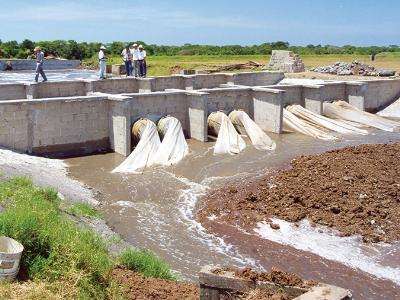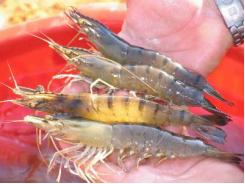Vibrio control in shrimp farming: Part 2

Few, if any, tools offer promise of long-term, cost-effective approaches
Successful Vibrio control strategies must revolve around limiting inputs, including those that come in with the water. Proper pond preparation is essential, as well.
The ecology in a shrimp or fish farm pond is a complex one, and each pond has its own, often unique traits and ecological composition. Vibrio bacteria are ubiquitous in marine environments and play a critical role in the recycling of chitin. This makes shrimp an easy target, since the animals’ skeletons are made of chitin.
Manipulation of the ecology is perhaps the most common tool of choice today in outdoor aquaculture production environments, but attempting to permanently change bacterial composition is likely not feasible. Bringing about meaningful short-term changes is at best challenging. There are, however, measures that aquafarmers can take to lessen the risks associated with Vibrios.
Microbiological links, natural barriers
All of the steps in the process of producing shrimp are linked microbiologically. Pathogens can be passed from infected females through and on their eggs into postlarvae production tanks. Artemia and algae can also carry strains of Vibrio that should not be added to postlarvae tanks. Proactive management strategies dictate controlling as many of these steps as possible to lower the bacterial loads that can move between these production systems.
Little is known about why certain strains of bacteria predominate in shrimp ponds. The ecology and water chemistries are intertwined, and the presence of various nutrients influences what bacterial types will thrive. Since bacteria are in constant competition for the available food, some bacteria dominate.
This could be because of a very short generation time. For some Vibrios, this is as short as 10 minutes. This means that in five hours, a single cell could generate more than 500 million daughter cells.
This means that in five hours, a single cell could generate more than 500 million daughter cells.
Competition for nutrients is likely the most important mechanism by which some bacteria dominate others. If not for such naturally occurring barriers, it would be very difficult to produce shrimp or fish in these systems.
Farm control strategies
Successful control strategies must revolve around limiting inputs, including those from postlarvae suppliers, those that come in with the water, those that might remain in the soil between crops and those in the feed and accumulated organic matter. Monitoring and controlling avoidable stressors are critical, as well. Stressed animals are more susceptible to diseases. If the production environment is stressful, the shrimp will let you know.
A critical control element was addressed in this column in the May/June Global Aquaculture Advocate regarding control of Vibrios in hatcheries to lower the loads of potentially problematic bacterial species. Practical control strategies at the farm level fall into a number of categories. The first is stress control. Higher water-exchange rates with clean water can lessen Vibrio loads and decrease the impacts of stressors by washing out organic material and other metabolites, such as ammonia. Aeration must be adequate to ensure dissolved-oxygen levels of 4 mg/L or higher during the early hours of the morning, when algal metabolism peaks and seriously reduces D.O. levels.
Proper pond preparation is essential, as well. This includes a total dryout, with the use of materials to kill whatever remains, as well as proper mixing and tilling of the sediments. Accumulated organic material, a very important source of nutrients for bacteria, is eliminated by this approach. Proper filtration of incoming water to lessen the carriers that enter the production system and the development of a mature ecology in ponds prior to stocking are all elements of this.
Bacterial amendments
Microbial amendments are finding widespread usage at farms. Coined probiotics — a term that is not only inaccurate scientifically, but misleading — there are hundreds of variants in the marketplace.
Although there is actually very little hard data that supports probiotic approaches as universally able to reduce the loads of Vibrios, there is nonetheless enough data for one to conclude products with appropriate compositions and prices that ensure farmers can use them at the levels needed do have niches as routine tools for use in shrimp and fish farms.
The products with the greatest potential are those based on spore formers. This is a stable form of a specific group of bacteria that are instrumental in the recycling of a wide variety of nutrients in terrestrial and aquatic ecosystems, the Bacillus species. The use of other types of bacteria can be problematic, primarily due to the short shelf lives of vegetative cells and the costs of producing stabilized forms that can tolerate extended exposure to temperatures above 90° C in warehouses.

Figure 1. Vibrio loads can be impacted in some production environments through the use of bacterial amendments.
The data in Figure 1 demonstrate that it is possible to impact Vibrio loads in some production environments through the use of probiotics. This product was able to substantially reduce the levels of bacteria that grew on the most common media used for Vibrio selection, thiosulfate citrate bile salts sucrose agar. Each treated pond showed a reproducible reduction in the loads.
Other tools
Many other tools are in various stages of development, but few, if any, actually offer the promise of long-term, effective and cost-effective approaches for controlling Vibrio loads in the average production environment.
It is clear that outdoor production of shrimp is the preferred production paradigm, and there will not be a mass migration to highly controlled indoor systems until the recirculating system industry gains much more momentum. There is good evidence to support the use of closed systems with multiple controls and limited water reuse to lower overall Vibrio loads, although biofloc-based systems can still contain very high levels of Vibrios.
Perspectives
Controlling Vibrios on farms is complicated and as much about controlling susceptibility as controlling the actual loads of these bacteria. The fact that Vibrios are largely benign and important for healthy functional ecosystems makes this even more challenging.
Reducing stressors, ensuring a firewall between the hatchery and the farm, proper pond preparation and the use of tools for the short-term manipulation of microbial ecology are all elements that should be part of the standard operating practices at farms.
The presence of bacteria in ponds is natural, and overly complex methods to alter the microbial flora can potentially backfire. Creating holes in the ecological fabric opens the door for the presence of other potentially problematic bacteria. Vibrios are not the only species that kill shrimp.
Stephen G. Newman, Ph.D.
- President and CEO
- AquaInTech Inc.
- 6722 162nd Place Southwest
- Lynnwood, Washington 98037-2716 USA
Related news
Tools

Phối trộn thức ăn chăn nuôi

Pha dung dịch thủy canh

Định mức cho tôm ăn

Phối trộn phân bón NPK

Xác định tỷ lệ tôm sống

Chuyển đổi đơn vị phân bón

Xác định công suất sục khí

Chuyển đổi đơn vị tôm

Tính diện tích nhà kính

Tính thể tích ao



 Shrimp farming in China: Lessons from its developmental…
Shrimp farming in China: Lessons from its developmental…  Regular population sampling of shrimp in ponds, part…
Regular population sampling of shrimp in ponds, part…